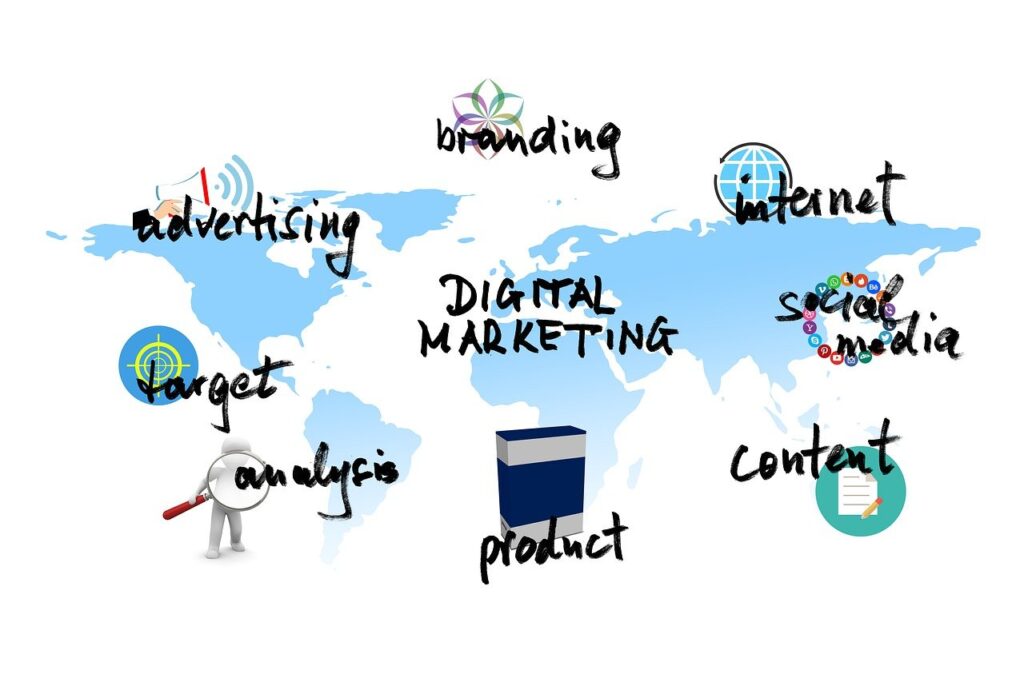Marketing, often perceived as an art as much as a science, plays a crucial role in communicating a company's values, products and services to its target customers. Let's delve into the types, channels and strategies of marketing to decipher what makes a brand resonate and a product compelling.
Marketing types
The marketing landscape is vast and diverse, offering an array of methods and practices designed to reach, engage and convert target audiences. In this section, we'll explore the main types of marketing that have emerged as fundamental in today's business world. We'll analyze how each type adapts to different brand strategies, and how professionals can use them effectively to drive the success of their marketing campaigns.
Traditional Marketing
Traditional marketing refers to the classic methods of advertising and promotion used before the advent of the Internet. These methods include television, radio, newspaper and magazine advertising, as well as the use of billboards and brochures. Despite the rise of digital marketing, traditional marketing remains an effective part of a brand's overall communications strategy, particularly useful for reaching less connected segments of the population or in specific geographical areas.
Television and radio advertising
Television and radio advertising can reach a large audience in a short space of time. Although it can be costly, it is particularly effective for building brand awareness and promoting products or services to a diverse audience.
Newspapers and Magazines
Newspaper and magazine advertising specifically targets readers interested in particular niches or sectors. This method offers the advantage of being able to reach specific demographic groups with tailored advertising content.
Billboards and Brochures
Billboards and brochures offer high visibility in strategic locations. They are used to attract attention in public places, and can be particularly relevant for promoting local events or special offers.
Traditional marketing, despite technological advances, continues to be an important pillar in building and maintaining a brand's presence. It complements digital marketing efforts by enabling a multi-sensory approach, maximizing the reach and effectiveness of the advertising message.
Digital Marketing
Digital marketing encompasses all marketing activities carried out via electronic or digital platforms. With the advent of the Internet and the constant evolution of technology, digital marketing has become a central element of a company's marketing strategy. It offers a multitude of advantages, including greater reach, the ability to target specific audiences with great precision, and a measurable return on investment. The main tactics used in digital marketing include SEO (Search Engine Optimization), content marketing, social network marketing, email marketing, and online paid advertising.
SEO (Search Engine Optimization)
SEO refers to all the techniques used to improve a website's ranking or visibility in search engine results pages. This involves optimizing content, improving site speed, and creating quality backlinks. A successful SEO strategy can significantly increase a website's organic traffic.
Content Marketing
Content marketing involves the creation and distribution of useful, relevant and engaging content designed to attract, inform and retain a target audience. This approach seeks to establish a relationship of trust and offer added value, rather than directly promoting a product or service.
Marketing on Social Networks
Social network marketing uses platforms like Facebook, Twitter, Instagram, and LinkedIn to promote a brand, product or service. It not only reaches a wider audience, but also engages and retains customers through direct interaction and community building.
Email marketing
Email marketing involves sending messages directly to a targeted group of email contacts. It's an effective way to promote products, share information, and maintain an ongoing relationship with customers. The emphasis is on personalization and message relevance to encourage email opening and engagement.
Paid Online Advertising
Paid online advertising, including PPC (Pay-Per-Click) and display ads, is used to drive traffic to a website by purchasing advertising space on digital platforms. Ads can be precisely targeted according to users' demographics, interests and online behavior, ensuring that the message reaches the most relevant audience.
These and other tactics make up the arsenal of digital marketing. Each can be used on its own, but it's by strategically combining them that companies can maximize their impact and achieve their growth objectives. Digital marketing is agile and constantly evolving, requiring constant monitoring and adaptability to make the most of the opportunities offered by digital.
Marketing channels
Digital marketing channels are essential for effectively reaching and engaging target audiences in today's fast-paced world. They offer companies a multitude of opportunities to communicate their messages, promote their products or services, and interact directly with their customers. Each channel, whether email marketing, paid advertising, SEO or social networks, has its own specificities and can be used strategically to achieve diverse marketing objectives. In this section, we'll explore the different digital marketing channels, their importance, and how to integrate them effectively into an overall marketing strategy to maximize their impact.
Online channels
Today's digital landscape offers an almost infinite variety of online channels through which brands can interact with their audiences. Each of these channels offers unique advantages and targets specific audiences, requiring a thoughtful, customized strategy for each platform.
Social Networks
Social networks remain one of the most powerful online channels for digital marketing. Platforms like Facebook, Instagram, LinkedIn and Twitter make it possible not only to share content and interact with customers, but also to precisely target audiences through advertising campaigns. Understanding the nuances of each platform and developing tailored content strategies can significantly increase engagement and strengthen brand presence.
Email marketing
Email marketing remains an effective method of reaching consumers directly. By developing an interested and engaged subscriber list, companies can communicate in a personalized way, provide relevant information and promote special offers. The use of segmentation and automation further enhances the effectiveness of email marketing, making campaigns more targeted and relevant to each audience segment.
Search Engine Optimization (SEO)
Optimizing content for search engines is crucial to improving a brand's online visibility. SEO involves fine-tuning the technical elements of the website and creating quality content that meets users' search criteria. A solid SEO strategy can increase organic traffic to the site, improve search rankings and, as a result, increase brand awareness.
Online advertising (SEM)
Paid advertising on search engines or social networks offers the possibility of precisely targeting audiences and achieving visible results quickly. Whether through Google Ads, Facebook Ads or other platforms, search engine marketing (SEM) enables ads to be placed directly in front of users who are actively searching for products or services similar to those offered by a brand. Properly managed, an SEM campaign can deliver considerable ROI by increasing reach and generating conversions.
Strategic use of these online channels, aligning them with business objectives and target audience preferences, is essential to building a robust online presence and generating meaningful engagement. The key lies in the ability to balance and integrate these different strategies to create a consistent and captivating experience for the consumer.
Offline channels
Even in the digital age, offline marketing channels remain a crucial complement to effectively reach certain market segments. These traditional channels, such as print ads, radio, TV and in-person events, offer tangible reach and can reinforce a brand's presence in consumers' daily lives.
Print advertising
Print advertising, whether in the form of posters, flyers or brochures, continues to be an effective way of capturing attention in physical spaces frequented by target audiences. A striking design and clear message can leave a lasting impression and support digital marketing efforts.
Radio and television advertising
Radio and television, with their large audiences, offer a unique opportunity to tell a brand's story and touch consumers in their everyday lives. Creating captivating, memorable content can boost brand recognition and encourage consumer engagement.
Events and Trade Shows
Participating in events, trade shows or organizing workshops can be a powerful way of interacting directly with the public. These face-to-face interactions build trust and deliver an immersive brand experience.
Direct Marketing
Direct marketing, thanks to targeted mail campaigns, makes it possible to reach a specific audience with personalized messages. This form of marketing can complement digital efforts by providing a personal touch that stands out in the age of digital communication.
The judicious integration of offline channels with online marketing strategies can amplify the overall impact of marketing campaigns. By creating synergies between digital and traditional channels, brands can create coherent campaigns that speak effectively to their target audience across multiple platforms.
Omnichannel approach
The omnichannel approach represents the natural evolution of multichannel marketing, focusing on a seamless, integrated customer experience, whatever the channel or platform used. This strategy recognizes that consumers interact with a brand through a variety of touchpoints, both online and offline, and aspires to provide a consistent, seamless experience at every stage of the customer journey.
Brand consistency
For a successful omnichannel strategy, it's crucial to maintain consistency in brand identity and messaging across all channels. This involves uniform communication and aligned visuals, ensuring that the consumer receives the same message, whether interacting with the brand online, via social networks, in-store, or through print advertising.
Personalized User Experience
Omnichannelity aims to personalize the user experience by collecting and analyzing customer data across different channels. This approach makes it possible to offer more relevant and personalized interactions, increasing consumer engagement and strengthening the relationship between the brand and its customers.
Channel integration
Effective integration of online and offline channels is essential to a successful omnichannel strategy. This can include the use of in-store technologies to enhance the shopping experience, e-mail marketing campaigns that direct customers to in-person events, or social advertising that promotes a click-and-collect service.
Ultimately, the omnichannel approach is driven by the desire to place the customer at the center of all brand operations. By adopting this strategy, companies can not only meet the high expectations of modern consumers, but also create memorable experiences that foster brand loyalty and drive growth.
Marketing strategies
In this section, we'll explore the different marketing strategies that have proven their effectiveness across various industries. From the growing importance of digital marketing to the inestimable value of traditional approaches, this section aims to provide an in-depth understanding of how a judicious combination of techniques can result in a successful campaign. We'll also discuss the importance of adaptability and innovation in developing a marketing strategy that not only meets current market needs but also anticipates future trends.
Inbound Marketing
Inbound marketing is a strategic approach that aims to attract consumers to the brand through the creation of relevant and useful content. Instead of interrupting consumers with advertising messages, this method seeks to establish a relationship of trust and value with the target audience.
Content creation
Creating quality content is at the heart of Inbound Marketing. Whether through blogs, videos, infographics or podcasts, content must provide answers to consumers' questions and needs. By offering valuable information, brands can position themselves as references in their field.
SEO strategies
To maximize the visibility of this content, a search engine optimization (SEO) strategy is essential. By optimizing content for search engines, brands improve their ranking in search results, increasing their chances of being discovered by interested consumers.
Social Network Marketing
Social network marketing also plays a crucial role in Inbound Marketing, enabling content to be shared with a wider audience and engaging directly with the public. An active and strategic presence on social networks can significantly increase brand awareness and encourage interaction with the content produced.
Marketing automation
To effectively manage the leads generated by these strategies, marketing automation is essential. It makes it possible to nurture prospects at different stages of the buying journey with personalized content, increasing the chances of conversion.
By adopting an Inbound Marketing approach, brands can build a strong and lasting online presence, attract qualified traffic to their platforms and cultivate meaningful relationships with their audience. This method aligns with the expectations of contemporary consumers, who prefer to interact with brands offering solutions to their needs, rather than being subjected to aggressive sales attempts.
Outbound Marketing
Outbound marketing is the opposite of inbound marketing. This traditional approach aims to deliver an advertising message directly to a large audience, often without prior consideration of the consumer's interest in or need for the product or service being promoted.
Traditional advertising
Outbound marketing methods include television, radio and print advertising, as well as the use of posters and billboards. These techniques seek to reach as many people as possible, with the hope that a fraction of this audience will respond to the call to action.
Direct Marketing
Direct marketing, in the form of emailing, direct mail or telephone calls, is another facet of Outbound Marketing. It involves contacting the consumer directly using contact databases, allowing a certain degree of personalization in the messages sent.
Trade Shows and Events
Participating in trade shows and organizing events are also Outbound Marketing strategies. These approaches offer the opportunity for face-to-face interaction with consumers and professional partners, enabling products or services to be presented and relationships to be built outside the digital space.
Advantages and limitations
Although often perceived as intrusive or less effective in the digital age, outbound marketing is still important. It is particularly useful for reaching specific segments of the population with less of an online presence, or for rapidly increasing brand awareness. However, its high cost and difficulty in measuring precise impact are significant challenges.
The art of contemporary marketing lies in a brand's ability to cleverly combine Inbound and Outbound approaches, drawing on their respective strengths to build a comprehensive and effective communications strategy.
Relationship Marketing
Relationship Marketing focuses on creating and maintaining long-term relationships with customers. Rather than focusing solely on isolated transactions, this approach aims to establish a deep and lasting connection with customers, thereby fostering loyalty and retention.
Personalized Interactions
Personalization plays a crucial role in relationship marketing. It involves treating each customer as a unique individual, with specific needs and preferences. By using customer data ethically to personalize communications and offers, brands can strengthen their relationships with their customers.
Loyalty programs
Loyalty programs are an effective tool for relationship marketing. By rewarding customers for their ongoing loyalty, brands encourage repeat purchases and strengthen their bond with their customers. These programs can take many forms, from discounts and exclusive offers to loyalty points convertible into rewards.
Customer Relationship Management (CRM)
The use of Customer Relationship Management (CRM) systems is essential to support an effective Relationship Marketing strategy. These tools enable companies to store, analyze and manage customer information, facilitating a personalized and consistent approach to all customer interactions.
Engagement on Social Networks
Social networks offer an ideal platform for Relationship Marketing. By actively engaging with their audience on these platforms, brands can build a loyal and interactive community. Social listening also provides valuable insights into customer needs and expectations, helping to improve offers and services.
In short, Relationship Marketing focuses on building a relationship of trust and mutual respect with customers. It moves away from the traditional transactional model to adopt a customer-centric approach, where interactions are not limited to the purchase, but form part of a global approach to long-term value creation.
Guerrilla Marketing
Guerrilla marketing is a bold, creative strategy designed to achieve maximum impact with limited resources. Its essence lies in the use of unconventional techniques to surprise, engage and leave a lasting impression on the target audience.
Street marketing
Street marketing is a key component of Guerrilla Marketing. It involves direct actions in public spaces, such as artistic performances, interactive installations, or product distributions, designed to capture the public's attention in unexpected and memorable ways.
Viral Marketing
Viral marketing aims to create content so captivating or entertaining that individuals feel compelled to share it with their networks. Thanks to the digital word-of-mouth effect, a campaign can quickly gain visibility and reach, often with a minimal budget.
Ambush advertising
Ambush advertising involves associating a brand with a major event without being an official sponsor. By exploiting the appeal and audiences of popular events, companies can capture attention in subtle and innovative ways.
Le Defi
While Guerrilla Marketing can be extremely effective in generating buzz and boosting brand awareness, it carries with it the risk of negative perception if campaigns are not well thought-out, or if they cross the boundaries of good taste or legality. The key is to strike a balance between bold creativity and cultural sensitivity.
In conclusion, Guerrilla Marketing offers companies the opportunity to stand out from the crowd in a crowded advertising world. By emphasizing originality and direct interaction with the audience, this approach creates memorable experiences that foster authentic engagement with the brand.
From marketing strategy innovative marketing channels marketing is an ever-changing landscape that requires flexibility and innovation. Whether you're a budding entrepreneur, a student with a passion for market strategy or a seasoned digital marketing professional, we hope this overview will help you navigate the complex waters of marketing.
By adopting a thoughtful, strategic approach, staying on top of trends and valuing the human connection, you can create marketing campaigns that not only captivate but also convert.
Marketing is more than just advertising; it's about creating stories that resonate and building lasting relationships. Keep learning, innovating and adapting, because in the ever-changing field of marketing, the opportunities are as limitless as your creativity.











